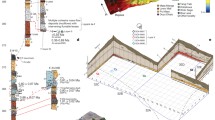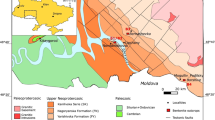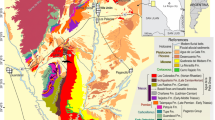Abstract
The cave infills at Sterkfontein contain one of the richest assemblages of Australopithecus fossils in the world, including the nearly complete skeleton StW 573 (‘Little Foot’)1,2,3,4 in its lower section, as well as early stone tools5,6,7 in higher sections. However, the chronology of the site remains controversial8,9,10,11,12,13,14 owing to the complex history of cave infilling. Much of the existing chronology based on uranium–lead dating10,11 and palaeomagnetic stratigraphy8,12 has recently been called into question by the recognition that dated flowstones fill cavities formed within previously cemented breccias and therefore do not form a stratigraphic sequence4,14. Earlier dating with cosmogenic nuclides9 suffered a high degree of uncertainty and has been questioned on grounds of sediment reworking10,11,13. Here we use isochron burial dating with cosmogenic aluminium-26 and beryllium-10 to show that the breccia containing StW 573 did not undergo significant reworking, and that it was deposited 3.67 ± 0.16 million years ago, far earlier than the 2.2 million year flowstones found within it10,11. The skeleton is thus coeval with early Australopithecus afarensis in eastern Africa15,16. We also date the earliest stone tools at Sterkfontein to 2.18 ± 0.21 million years ago, placing them in the Oldowan at a time similar to that found elsewhere in South Africa at Swartkans17 and Wonderwerk18.



Similar content being viewed by others
References
Clarke, R. J. & Tobias, P. V. Sterkfontein member 2 foot bones of the oldest South African hominid. Science 269, 521–524 (1995)
Clarke, R. J. First ever discovery of a skull and well preserved skeleton of Australopithecus. S. Afr. J. Sci. 94, 460–463 (1998)
Clarke, R. J. Newly revealed information on the Sterkfontein Member 2 Australopithecus skeleton. S. Afr. J. Sci. 98, 523–526 (2002)
Clarke, R. J. A deeper understanding of the stratigraphy of Sterkfontein fossil hominid site. Trans. R. Soc. S. Afr. 61, 111–120 (2006)
Kuman, K. The archaeology of Sterkfontein: past and present. J. Hum. Evol. 27, 471–495 (1994)
Kuman, K. & Clarke, R. J. Stratigraphy, artefact industries, and hominid associations for Sterkfontein Member 5. J. Hum. Evol. 38, 827–847 (2000)
Kuman, K. & Field, A. S. in The Cutting Edge: New Approaches to the Archaeology of Human Origins (eds Schick, K. & Toth, T. ) 151–169 (Stone Age Institute Press, 2009)
Partridge, T. C., Shaw, J., Heslop, D. & Clarke, R. J. The new hominid skeleton from Sterkfontein, South Africa: age and preliminary assessment. J. Quat. Sci. 14, 293–298 (1999)
Partridge, T. C., Granger, D. E., Caffee, M. W. & Clarke, R. J. Lower Pliocene hominid remains from Sterkfontein. Science 300, 607–612 (2003)
Walker, J., Cliff, R. A. & Latham, A. G. U-Pb isotopic age of the StW 573 hominid from Sterkfontein, South Africa. Science 314, 1592–1594 (2006)
Pickering, R. & Kramers, J. D. Re-appraisal of the stratigraphy and determination of new U-Pb dates for the Sterkfontein hominin site, South Africa. J. Hum. Evol. 59, 70–86 (2010)
Herries, A. I. R. & Shaw, J. Paleomagnetic analysis of the Sterkfontein paleocave deposits: implications for the age of the hominin fossils and stone tool industries. J. Hum. Evol. 60, 523–539 (2011)
Herries, A. I. R. et al. in The Paleobiology of Australopithecus (eds Reed, K. E., Fleagle, J. G. & Leakey, R. E. ) 21–40 (Springer, 2013)
Bruxelles, L., Clarke, R. J., Maire, R., Ortega, R. & Stratford, D. Stratigraphic analysis of the Sterkfontein StW 573 Australopithecus skeleton and implications for its age. J. Hum. Evol. 70, 36–48 (2014)
Drake, R. & Curtis, G. H. in Laetoli: A Pliocene Site in Northern Tanzania (eds Leakey, M. D. & Harris, J. M. ) 48–52 (Clarendon, 1987)
Haile-Selassie, Y. et al. An early Australopithecus afarensis postcranium from Woranso-Mille, Ethiopia. Proc. Natl Acad. Sci. USA 107, 12121–12126 (2010)
Gibbon, R. J. et al. Cosmogenic nuclide burial dating of hominin-bearing Pleistocene cave deposits at Swartkrans, South Africa. Quat. Geochronol. 24, 10–15 (2014)
Chazan, M. D. et al. The Oldowan horizon in Wonderwerk Cave (South Africa): archaeological, geological, paleontological, and paleoclimatic evidence. J. Hum. Evol. 63, 859–866 (2012)
Partridge, T. C. Re-appraisal of lithostratigraphy of Sterkfontein hominid site. Nature 275, 282–287 (1978)
Partridge, T. C. & Watt, I. B. The stratigraphy of the Sterkfontein hominid deposit and its relationship to the underground cave system. Palaeontol. Afr. 28, 35–40 (1991)
Pickering, T. R., Clarke, R. J. & Heaton, J. L. The context of StW 573, an early hominid skull and skeleton from Sterkfontein Member 2: taphonomy and paleoenvironment. J. Hum. Evol. 46, 277–295 (2004)
Clarke, R. J. in Integrative Paths to the Past: Essays in Honor of F. Clark Howell (eds Corruccini, R. S. & Ciochon, R. L. ) 205–222 (Prentice Hall, 1994)
Dart, R. A. The Makapansgat proto-human Australopithecus prometheus. Am. J. Phys. Anthropol. 6, 259–284 (1948)
Granger, D. E. in Treatise on Geochemistry 2nd edn (eds Holland, H. D. & Turekian, K. K. ) Vol. 14 81–97 (Elsevier, 2014)
Balco, G. & Rovey, C. W. An isochron method for cosmogenic-nuclide dating of buried soils and sediments. Am. J. Sci. 308, 1083–1114 (2008)
Erlanger, E. D., Granger, D. E. & Gibbon, R. J. Rock uplift rates in South Africa from isochron burial dating of fluvial and marine terraces. Geology 40, 1019–1022 (2012)
Balco, G., Soreghan, G. S., Sweet, D. E., Marra, K. R. & Bierman, P. R. Cosmogenic-nuclide burial ages for Pleistocene sedimentary fill in Unaweep Canyon, Colorado, USA. Quat. Geochronol. 18, 149–157 (2013)
Nishiizumi, K. Preparation of 26Al AMS standards. Nucl. Instrum. Methods B 223, 388–392 (2004)
Chmeleff, J., von Blanckenburg, F., Kossert, K. & Jakob, D. Determination of the 10Be half-life by multicollector ICP-MS and liquid scintillation counting. Nucl. Instrum. Methods B 268, 192–199 (2010)
Nishiizumi, K. et al. Absolute calibration of 10Be AMS standards. Nucl. Instrum. Methods B 258, 403–413 (2007)
Acknowledgements
This work results from a collaboration begun with T. C. Partridge (deceased). AMS development and measurements were funded by National Science Foundation EAR1153689 to M.W.C. and D.E.G. and National Science Foundation EAR0844151 to D.E.G. Major funding to R.J.G., K.K. and R.J.C. was received from the Palaeontological Scientific Trust (PAST), which has supported research at Sterkfontein for 20 years. R.J.G. received bursary support from the National Research Foundation (NRF) of South Africa. K.K. thanks the NRF (SA) for substantial funding (AOP 1207112551-82611 and AOP1207173196-82591) and Prof. Bruce Rubidge of the Evolutionary Studies Institute for additional support. Figure 1 includes modified material from J. Hum Evol. vol. 70, Bruxelles L. et al., Stratigraphic analysis of the Sterkfontein StW 573 Australopithecus skeleton and implications for its age, 36–48 (2014), with permission from Elsevier.
Author information
Authors and Affiliations
Contributions
D.E.G. and R.J.G. conceived the project and performed laboratory work and data analysis. K.K. and R.J.C. supervised sample collection and interpretation of the dates. L.B. was responsible for mapping and interpretation of Member 2. M.W.C. supervised AMS measurements and methods development. All authors contributed to writing the manuscript.
Corresponding author
Ethics declarations
Competing interests
The authors declare no competing financial interests.
Extended data figures and tables
Extended Data Figure 1 Hand-picked samples.
Dark-coloured and light-coloured grains separated for samples M2 Dark and M2 Light. Each dish contains grains from the labelled original sample; M2 lower is sample ST 1, and M2 middle is ST 2. Light-coloured angular clasts in the top two dishes were combined into sample M2 Light, while the iron-stained and rounded clasts in the remaining dishes were combined into sample M2 Dark.
Extended Data Figure 2 Manuport.
Quartz manuport analysed from the Oldowan Infill. Maximum dimension is 67 mm. Sample recovered from Square Q57 spit 27′ 8′′–28′ 8′′.
Rights and permissions
About this article
Cite this article
Granger, D., Gibbon, R., Kuman, K. et al. New cosmogenic burial ages for Sterkfontein Member 2 Australopithecus and Member 5 Oldowan. Nature 522, 85–88 (2015). https://doi.org/10.1038/nature14268
Received:
Accepted:
Published:
Issue Date:
DOI: https://doi.org/10.1038/nature14268
- Springer Nature Limited
This article is cited by
-
East-to-west human dispersal into Europe 1.4 million years ago
Nature (2024)
-
Reappraising the palaeobiology of Australopithecus
Nature (2023)
-
The effects of mid-to-late Pliocene climatic fluctuations on the habitat and distribution of early hominins
Human Ecology (2023)
-
Cosmogenic nuclide techniques
Nature Reviews Methods Primers (2022)
-
Eolian chronology reveals causal links between tectonics, climate, and erg generation
Nature Communications (2022)





